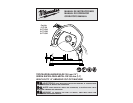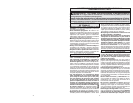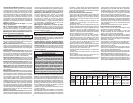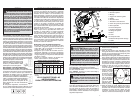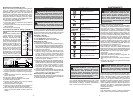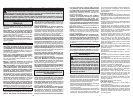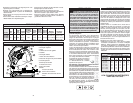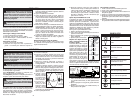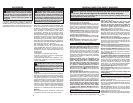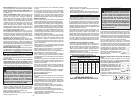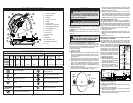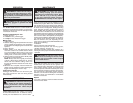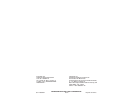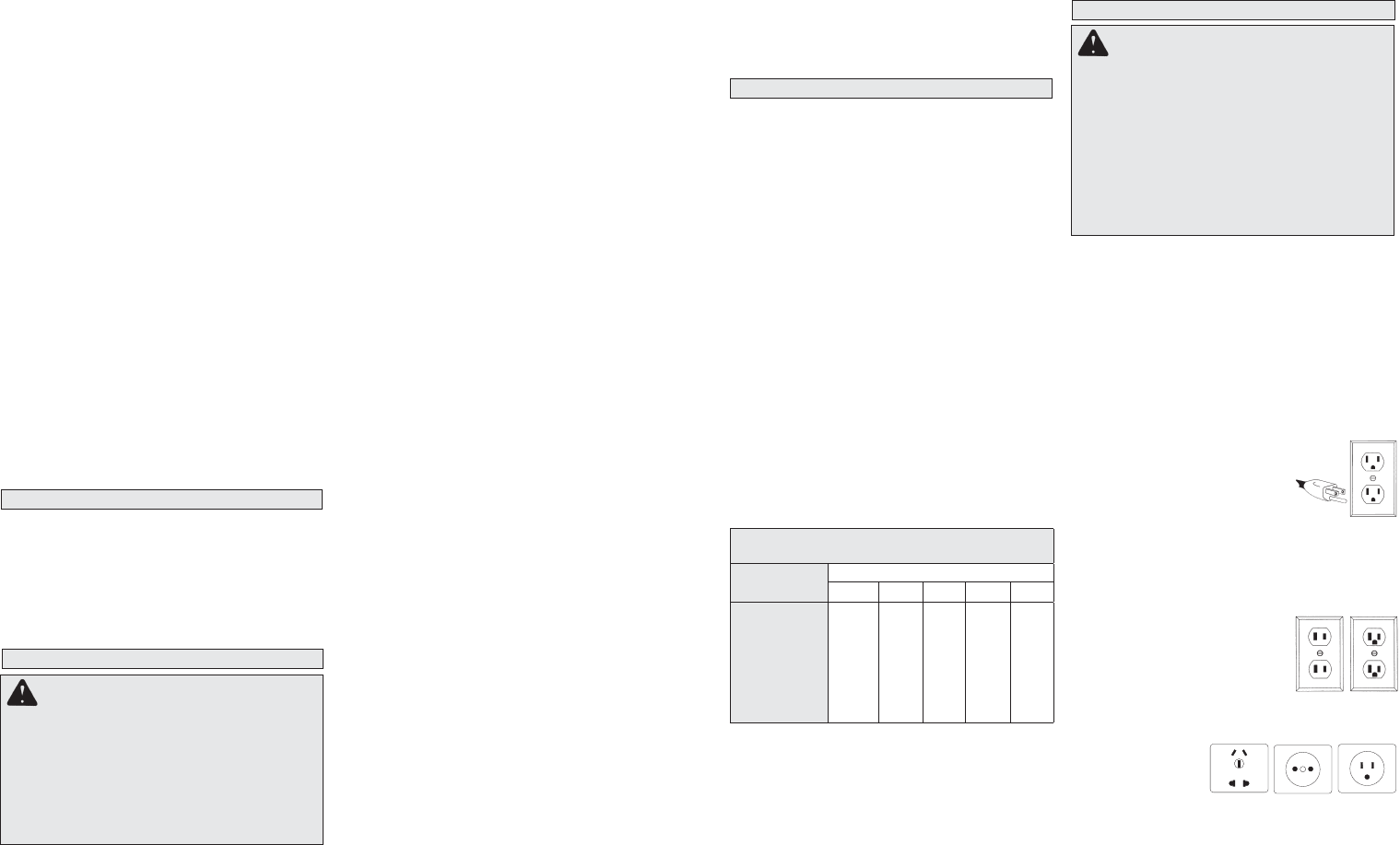
18
19
SPECIFIC SAFETY RULES
• Store idle tools. When not in use, store your tool in
a dry, secured place. Keep out of reach of children.
• Never leave the tool running unattended. Turn
power off. Do not leave the tool until it comes to a
complete stop.
• Check for damaged parts. Inspect guards and
other parts before use. Check for misalignment,
binding of moving parts, improper mounting,
broken parts and any other conditions that may
affect operation. If abnormal noise or vibration
occurs, turn the tool off immediately and have the
problem corrected before further use. Do not use
a damaged tool. Tag damaged tools “DO NOT
USE” until repaired. A guard or other damaged
part should be properly repaired or replaced by a
MILWAUKEE service facility. For all repairs, insist
on only identical replacement parts.
• Use proper accessories. Consult this manual
for recommended accessories. Using improper
accessories may be hazardous. Be sure acces-
sories are properly installed and maintained. Do
not defeat a guard or other safety device when
installing an accessory or attachment.
• Maintain tools carefully. Keep handles dry,
clean and free from oil and grease. Keep cutting
edges sharp and clean. Follow instructions for
lubricating and changing accessories. Periodically
inspect tool cords and extension cords for damage.
Have damaged parts repaired or replaced by a
MILWAUKEE service facility.
• Maintain labels & nameplates. These carry impor-
tant information. If unreadable or missing, contact a
MILWAUKEE service facility for a free replacement.
SERVICE
• Tool service must be performed only by quali-
fi ed repair personnel. Service or maintenance
performed by unqualifi ed personnel may result in
a risk of injury.
• When servicing a tool, use only identical
replacement parts. follow instructions in the
maintenance section of this manual. Use of
unauthorized parts or failure to follow maintenance
instructions may create a risk of shock or injury.
• WARNING: Some dust created by power sanding,
sawing, grinding, drilling, and other construction
activities contains chemicals known to cause
cancer, birth defects or other reproductive harm.
Some examples of these chemicals are:
• lead from lead-based paint
• crystalline silica from bricks and cement and other
masonry products, and
• arsenic and chromium from chemically-treated
lumber.
Your risk from these exposures varies, depending
on how often you do this type of work. To reduce
your exposure to these chemicals: work in a well
ventilated area, and work with approved safety
equipment, such as those dust masks that are
specially designed to fi lter out microscopic particles.
Wheel Instructions
• Use only the edge (not the sides) of the wheel for
cutting. Do not allow the wheel to twist or bind.
• Keep hands and body away from the rotating wheel.
Do not wear loose clothing when using this tool.
• Store cut-off wheels with care. Do not drop them or
subject them to excessive heat, cold or humidity.
• Make sure that all wheel fl anges and other mount-
ing hardware are in good condition and are always
used properly. Defective or missing parts may
cause damage to the wheel. Always use mounting
fl anges supplied with the tool.
• Cutting with a damaged wheel is very hazard-
ous. After installing a new wheel, leave the tool
unplugged and rotate the wheel by hand to see
if it is uneven, warped, or cracked. If so, discard
the wheel and replace it with a new one. Do not
use a wheel that has been dropped; impact may
result in breakage.
• Before starting a cut, step back from the tool and
make a trial run to confi rm that the wheel is in good
condition. Trial run periods are:
When replacing a cut-off wheel — over 3 minutes.
When starting routine work — over 1 minute.
• Never try to remove or clamp the workpiece to the
tool while the cut-off wheel is rotating.
• Before installing a cut-off wheel, always inspect
it for cracks. Visually check resinoid and rubber-
bonded wheels for cracks. Replace cracked wheel
immediately.
• Always check maximum operating speed estab-
lished for wheel against machine speed. Do not
exceed the maximum operating speed that is
marked on the wheel.
• Do not force a wheel onto the machine or alter the
size of the arbor hole. Don’t use a wheel that fi ts
the arbor too loosely. If the wheel doesn’t fi t the
machine, get one that does.
• Do not attempt to install saw blades on this tool
because it is not designed for this type of blade.
• Do not overtighten wheel nut.
Machine Instructions
• Start cutting only after the motor has reached full
speed.
• Release switch immediately if the cut-off wheel
stops rotating or if the motor sounds like it is straining.
• Keep fl ammable and fragile objects away from
this tool. Do not allow cut-off sparks to contact the
operator’s hands, face or feet.
• Place the tool securely on a fl at, level surface.
• Always use the tool with the proper voltage speci-
fi ed on the tool’s nameplate.
• Never touch a short cut-off piece until it cools.
• Never attempt to cut material larger than the rated
capacity listed in “Specifi cations”.
• Never stand in line with the wheel while cutting.
Always stand to the side.
WARNING To reduce the risk of injury,
avoid inhalation of dust generated by
grinding and cutting operations. Exposure
to dust may cause respiratory ailments.
Use approved NIOSH or OSHA respirators,
safety glasses or face shields, gloves and
protective clothing. Provide adequate
ventilation to eliminate dust, or to maintain
dust level below the Threshold Limit Value for
nuisance dust as classifi ed by OSHA.
• Always keep guards in place.
• Always start the cut gently. Do not bump or bang
a wheel to start a cut.
• Never make any freehand cuts. Always place the work-
piece between the vise and fence when making cuts.
Grounded tools require a three wire extension
cord. Double insulated tools can use either a two
or three wire extension cord. As the distance from
the supply outlet increases, you must use a heavier
gauge extension cord. Using extension cords with
inadequately sized wire causes a serious drop in
voltage, resulting in loss of power and possible tool
damage. Refer to the table shown to determine the
required minimum wire size.
The smaller the gauge number of the wire, the
greater the capacity of the cord. For example, a 14
gauge cord can carry a higher current than a 16
gauge cord. When using more than one extension
cord to make up the total length, be sure each cord
contains at least the minimum wire size required.
If you are using one extension cord for more than
one tool, add the nameplate amperes and use the
sum to determine the required minimum wire size.
Guidelines for Using Extension Cords
• If you are using an extension cord outdoors, be
sure it is marked with the suffi x “W-A” (“W” in Cana-
da) to indicate that it is acceptable for outdoor use.
• Be sure your extension cord is properly wired
and in good electrical condition. Always replace a
damaged extension cord or have it repaired by a
qualifi ed person before using it.
• Protect your extension cords from sharp objects,
excessive heat and damp or wet areas.
READ AND SAVE ALL
INSTRUCTIONS FOR FUTURE USE.
* Based on limiting the line voltage drop to fi ve volts at
150% of the rated amperes.
EXTENSION CORDS
Recommended Minimum Wire Gauge
or Extension Cords*
Nameplate
Amperes
Extension Cord Length
25' 50' 75' 100' 150'
0 - 2.0
2.1 - 3.4
3.5 - 5.0
5.1 - 7.0
7.1 - 12.0
12.1 - 16.0
16.1 - 20.0
18
18
18
18
16
14
12
18
18
18
16
14
12
10
8
18
16
14
12
10
--
18
16
14
12
10
--
--
16
14
12
12
--
--
--
Fig. B
Fig. C
Fig. A
GROUNDING
Grounded Tools: Tools with Three Prong Plugs
Tools marked “Grounding Required” have a three
wire cord and three prong grounding plug. The
plug must be connected to a properly grounded
outlet (See Figure A). If the tool should electrically
malfunction or break down, grounding provides a
low resistance path to carry electricity away from
the user, reducing the risk of electric shock.
The grounding prong in the plug is connected
through the green wire inside the cord to the
grounding system in the tool. The green wire in the
cord must be the only wire connected to the tool's
grounding system and must never be attached to
an electrically “live” terminal. Your tool must
be plugged into an appropriate outlet, prop-
erly installed and grounded in accordance
with all codes and ordinances. The
plug and outlet should look like
those in Figure A.
Double Insulated Tools: Tools with Two Prong
Plugs
Tools marked “Double Insulated” do not require
grounding. They have a special double insulation
system which satisfi es OSHA requirements and com-
plies with the applicable standards of
Underwriters Laboratories, Inc., the
Canadian Standard Association and
the National Electrical Code. Double
Insulated tools may be used in either
of the 120 volt outlets shown in
Figures B and C.
In specifi c countries, double insu-
lated tools could be used in the output connections
suitable for the plug.
WARNING Improperly connecting the
grounding wire can result in the risk of elec-
tric shock. Check with a qualifi ed electrician
if you are in doubt as to whether the outlet is
properly grounded. Do not modify the plug
provided with the tool. Never remove the
grounding prong from the plug. Do not use
the tool if the cord or plug is damaged. If
damaged, have it repaired by a MILWAUKEE
service facility before use. If the plug will not
fi t the outlet, have a proper outlet installed by
a qualifi ed electrician.



